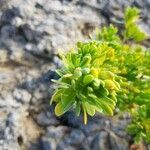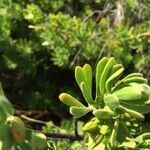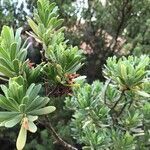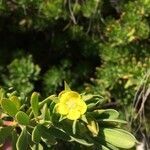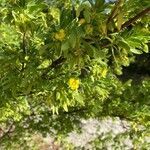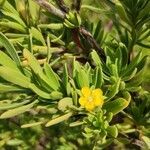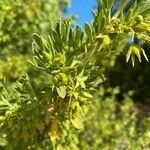Shrubs or small trees, 1-3 m tall. Branches pubescent, with partially capitate glandular setae when young; branchlets dense, often with scar. Leaves with very short petiole, often fascicled at ends of branchlets; leaf blade somewhat fleshy, narrowly oblanceolate, 25-35 × ca. 5 mm, base gradually narrow, margin entire, apex obtuse; veins inconspicuous. Cymes axillary, 2-4-flowered; bracts lanceolate, 4-9 × 1-1.5 mm, pubescent; pedicel ca. 1 cm, pubescent. Sepals ovate-lanceolate or ovate-oblong, 5-10 × 2-4 mm, pubescent. Petals yellow, imbricate, obovate, oblong, or rounded, with short claw, deciduous. Filaments basally villous, ca. 5 mm. Carpels hairy, obovoid to globose; styles glabrous, ca. 5 mm; stigma small but conspicuous. Drupe pubescent, subglobose, ca. 3.5 mm, with persistent basifixed style. Fl. Jun-Jul, fr. Aug-Oct.
Shrub or small tree, up to 3(-8?) m, rather densely pubescent in all the younger parts; hairs partly glandular-capitate. Wood very hard. Leaves somewhat fleshy, linear-spathulate, up to 3.5 by 0.5 cm, crowded at the end of the branchlets, leaving tuberculate scars; midrib, nerves, and veins inconspicuous. Inflorescences 2-4-flowered. Bracts lanceolate, 4-9 by 1-1.5 mm. Pedicels up to c. 1 cm. Sepals ovate-lanceolate to ovate-oblong, 5-10 by 2-4 mm. Petals yellow, ± obovate-oblong to orbicular, shortly clawed, about as long as the sepals. Filaments sericeous at the base, up to 5 mm; anthers with emarginate top and base, 1 mm ø. Carpels hairy, obovoid, in anthesis up to c. 1 mm long; styles glabrous, except at the very base, up to 5 mm. Fruits hairy, subovoid, c. 3.5 mm long.
Leaf-lamina 10–40 × 3–4 mm., linear-spathulate to oblanceolate, obtuse to subacute at the apex, margin entire, cuneate at the base,: ± pubescent on both sides; petiole c. 1 mm. long, glandular-pubescent.
Inflorescence as long as or shorter than the leaves; branches of inflorescence densely glandular-pubescent; bracts c. 4 mm. long, linear or linear-subulate, densely pubescent.
Carpels ± obovoid-ellipsoid, free but closely appressed together; styles c. 4 mm. long, slender, glabrous except at the base, free but closely appressed together.
Petals yellow, c. 7 × 5 mm., oblong to obovate, apex rounded, margin ciliolate, base shortly clawed.
Much-branched shrub up to 2 m. tall; branches greyish-velvety-hairy or thinly pubescent when older.
Ripe fruiting carpels blackish, c. 3·5 × 3 mm., obovoid, with two faces ± compressed, pubescent.
Stamens with longer filaments c. 4·5 mm. long and shorter ones c. 3·5 mm. long.
Calyx c. 8 mm. long, glandular-pubescent; lobes lanceolate-acuminate.
